deployment of the PLA Navy ships in the - Information Resource ...
deployment of the PLA Navy ships in the - Information Resource ...
deployment of the PLA Navy ships in the - Information Resource ...
Create successful ePaper yourself
Turn your PDF publications into a flip-book with our unique Google optimized e-Paper software.
FFFFFFFFFFFFFFFFFFF<br />
countries, perhaps, <strong>the</strong>re is a need to exam<strong>in</strong>e surface<br />
platforms which could be lightly armed with fairly long<br />
legs to undertake missions <strong>of</strong> this nature without<br />
hav<strong>in</strong>g <strong>the</strong> requirement to carry out an enroute OTR<br />
or tag along a replenishment ship.<br />
RECOMMENDATIONS<br />
Today <strong>the</strong> enemy is slowly and steadily resort<strong>in</strong>g<br />
to ‘asymmetric’ warfare as aga<strong>in</strong>st a full fledged war.<br />
Therefore, <strong>the</strong> ‘Armed Forces’ <strong>in</strong> general and <strong>the</strong><br />
Navies <strong>in</strong> particular will have to build capabilities and<br />
hone skills to take on challenges from <strong>the</strong> lowest end<br />
<strong>of</strong> conflict spectrum viz Low Intensity Maritime<br />
Operations (LIMO) to <strong>the</strong> highest end <strong>of</strong> conflict such<br />
as Nuclear warfare. Therefore, whilst <strong>the</strong>re has been<br />
an <strong>in</strong>crease <strong>in</strong> <strong>the</strong> asymmetric threats, <strong>the</strong> threat <strong>of</strong> a<br />
conventional warfare hasn’t dim<strong>in</strong>ished ei<strong>the</strong>r, what<br />
with each nation still jostl<strong>in</strong>g for ‘strategic space’ for its<br />
<strong>in</strong>dependent growth and development. If anyth<strong>in</strong>g,<br />
<strong>in</strong>flux <strong>of</strong> extra regional navies <strong>in</strong> <strong>the</strong> Indian Ocean has<br />
been on <strong>the</strong> rise be it Op Endur<strong>in</strong>g Freedom,<br />
Afghanistan and GWOT, Energy security , anti piracy<br />
ops <strong>of</strong>f Somalia, etc. The Indian <strong>Navy</strong> <strong>of</strong> 2020 would<br />
accord<strong>in</strong>gly need to gear itself towards this direction.<br />
Some recommended roles <strong>of</strong> <strong>the</strong> Indian <strong>Navy</strong> for <strong>the</strong><br />
com<strong>in</strong>g decade is given <strong>in</strong> <strong>the</strong> succeed<strong>in</strong>g<br />
paragraphs.<br />
Conventional Roles <strong>of</strong> IN – Strategic Level<br />
Deterrence by Perception Management.<br />
As Sun Tzu had said ‘<strong>the</strong> true art <strong>of</strong> war fight<strong>in</strong>g lies <strong>in</strong><br />
w<strong>in</strong>n<strong>in</strong>g wars without fight<strong>in</strong>g and this can be<br />
achieved by attack<strong>in</strong>g <strong>the</strong> enemy’s m<strong>in</strong>d’. India needs<br />
to exploit all resources for proper and effective<br />
‘perception management’ <strong>of</strong> our likely adversaries.<br />
This could probably be possible by cont<strong>in</strong>uous<br />
monitor<strong>in</strong>g <strong>of</strong> <strong>the</strong> prevail<strong>in</strong>g geo-strategic, geoeconomic<br />
and geo-political environment. Based on<br />
a detailed study, <strong>the</strong> prevail<strong>in</strong>g geo-strategic<br />
environment would need to be ‘shaped’ so as to<br />
achieve credible deterrence.<br />
Nuclear Deterrence. Nuclear Deterrence is<br />
a sub-set <strong>of</strong> strategic deterrence, whose long term<br />
goal is to ensure stability. Our ‘No First Use ‘(NFU) policy<br />
amply illustrates India’s <strong>in</strong>tentions <strong>of</strong> us<strong>in</strong>g <strong>the</strong> nuclear<br />
deterrence only as a retaliatory measure <strong>of</strong> last resort.<br />
The sea – based leg <strong>of</strong> <strong>the</strong> nuclear triad enables a<br />
survivable second strike capability and is, <strong>the</strong>refore, a<br />
critical enabler for <strong>the</strong> nuclear doctr<strong>in</strong>e <strong>of</strong> NFU to atta<strong>in</strong><br />
credibility. The nuclear armed missile submar<strong>in</strong>e is <strong>the</strong><br />
preferred arsenal for small nuclear forces.<br />
Co-operative Engagement. There is a need<br />
to constructively engage <strong>the</strong> regional as well as extraregional<br />
powers both at <strong>the</strong> national (diplomatic) level<br />
as well as at <strong>the</strong> levels <strong>of</strong> <strong>the</strong> respective Navies. The<br />
conduct <strong>of</strong> <strong>the</strong> IONS (Indian Ocean Naval Symposium)<br />
<strong>in</strong> 2008 as well as conduct <strong>of</strong> regular exercises with<br />
<strong>the</strong> US, French, Japanese as well as o<strong>the</strong>r region<br />
navies are perhaps roles which <strong>the</strong> Indian <strong>Navy</strong> would<br />
have to cont<strong>in</strong>ue for <strong>the</strong> next decade to achieve its<br />
desired effect <strong>in</strong> <strong>the</strong> region as well as at <strong>the</strong> global level.<br />
Conventional Roles <strong>of</strong> IN – Operational Level<br />
Ship Borne Ballistic Missile Defence<br />
(BMD) Capability. In Dec 2007, after some jo<strong>in</strong>t<br />
tests, Japanese warship JS ‘Kongo’ (DDG 173)<br />
successfully <strong>in</strong>tercepted a Ballistic Missile. In 2010, <strong>the</strong><br />
JSDMF will achieve <strong>the</strong> operational capability: with four<br />
‘Kongo’ class destroyers fitted with block 2004 AEGI<br />
BMD 3.6, and SM-3 Block 1A missiles (n<strong>in</strong>e <strong>in</strong>terceptors<br />
per ship). After 2012 two ‘Atago Class destroyers will<br />
be declared BMD capable. This capability would<br />
enable JSDMF <strong>ships</strong> to protect <strong>the</strong> entire Japanese<br />
territory aga<strong>in</strong>st Korean launched BMD threats. In <strong>the</strong><br />
Pacific area, South Korea and Australia too have vested<br />
<strong>in</strong>terests on BMD. Whilst South Korea is likely to fit SM-<br />
6 FT-SBT on <strong>the</strong> new three KDX-3 destroyers, Australia<br />
is likely to fit BMD capability on <strong>the</strong> future ‘Hobart’ Class<br />
AEGIS air defence destroyers. The o<strong>the</strong>r countries<br />
<strong>in</strong>volved <strong>in</strong> <strong>the</strong> BMD fitment onboard <strong>the</strong>ir war<strong>ships</strong><br />
<strong>in</strong>clude Canada, Germany, Italy, <strong>the</strong> Ne<strong>the</strong>rlands,<br />
Spa<strong>in</strong>, UK and US.<br />
BMD and Anti-Satellite Capability. On 20<br />
Feb 2008, USS ‘Lake Erie’ (CG 70) performed one <strong>of</strong><br />
<strong>the</strong> most exotic and unexpected missions a naval<br />
vessel was ever entrusted with. In this mission ‘Lake<br />
Erie’ successfully shot down an old US spy satellite<br />
which due to some technical reason was spiral<strong>in</strong>g out<br />
<strong>of</strong> control and was likely to re-enter <strong>the</strong> earth’s<br />
atmosphere. The satellite conta<strong>in</strong>ed 500 Kg <strong>of</strong><br />
hydraz<strong>in</strong>e, a highly toxic material, which could have<br />
caused high level <strong>of</strong> death and destruction to human<br />
lives. The satellite was engaged by a modified anti-<br />
FFFFFFFFF SEPTEMBER 2010<br />
FFFFFFFFF18



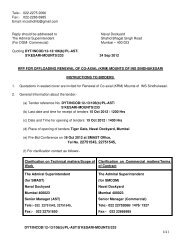

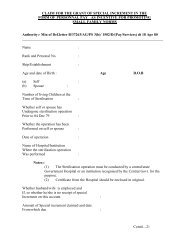
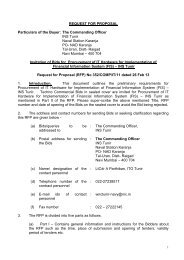
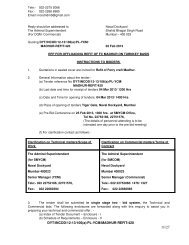
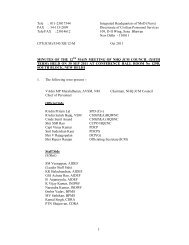

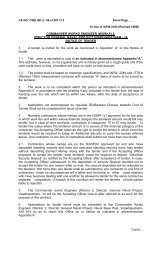
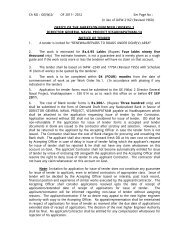
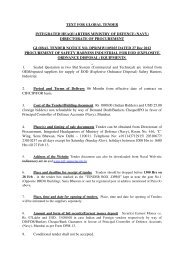
![DGNP[V] - Irfc-nausena.nic.in](https://img.yumpu.com/23509938/1/158x260/dgnpv-irfc-nausenanicin.jpg?quality=85)



